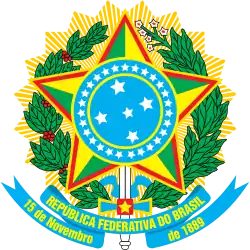| This article is part of a series on the |
 |
|---|
Parliamentary elections were held in Brazil on 14 October 1934 to elect members of the Chamber of Deputies and state legislatures.[1]
Background
Following the Brazilian Revolution of 1930, a constitutional assembly was elected in 1933 and drew up a new constitution, which came into force on 16 July 1934.[2] It provided for a federal state with a bicameral parliament consisting of a 300-member Chamber of Deputies (of which 250 were directly elected and 50 selected by union and employer bodies) and a Senate consisting of two members from each state, who would be elected by state legislatures.[2][3]
After the constitution was promulgated, the Assembly was converted into a Chamber of Deputies and elected Getúlio Vargas as president the following day.[2]
Electoral system
The 250 directly elected members were elected by open list proportional representation, with states acting as constituencies.[3][4] Voters could cast preferential votes for candidates from multiple parties.[4]
Results
Of the 250 elected members, 142 were supporters of Vargas, 76 were from the opposition and 32 were independents.[5]
| Party | Seats | |
|---|---|---|
| Progressive Party | 35 | |
| Social Democratic Party | 30 | |
| São Paulo Constitutionalist Party | 22 | |
| Social Democratic Party of Pernambuco | 15 | |
| Liberal Republican Party | 14 | |
| Paulista Republican Party | 12 | |
| Minas Republican Party | 11 | |
| Republican Party | 10 | |
| Fluminense Progressive Union | 9 | |
| United Front | 8 | |
| Catholic Electoral League | 8 | |
| Autonomist Party | 8 | |
| Governor Captain Octavia Mangabeira | 7 | |
| Pará Liberal Party | 7 | |
| Radical People's Party | 5 | |
| Catarinense Liberal Party | 4 | |
| Socialist National Party | 4 | |
| Pelo Amazonas Redimido | 4 | |
| Mato Grosso Evolutionist Party | 3 | |
| People's Party | 3 | |
| Republican Social Party | 3 | |
| Republican Union | 3 | |
| Alliance for Santa Catarina | 2 | |
| Social Alliance | 2 | |
| Chapa Popular | 2 | |
| Pernambucana Dissidents | 2 | |
| Paraense United Front | 2 | |
| Fluminense Socialist Party | 2 | |
| Libertarian Union | 2 | |
| Libertarian Coalition | 1 | |
| Piauhyense Coalition | 1 | |
| Agriculture Party | 1 | |
| Fluminense Evolutionary Party | 1 | |
| Mato Grossense Liberal Party | 1 | |
| National Party | 1 | |
| Libertarian Republican Party | 1 | |
| Nationalist Social Party | 1 | |
| Progressive Republicans | 1 | |
| Maranhense Republican Union | 1 | |
| Paranaense Republican Union | 1 | |
| Indirectly elected members | 50 | |
| Total | 300 | |
| Source: TSE | ||
References
- ↑ C. Peixoto-Mehrtens (2010). Urban Space and National Identity in Early Twentieth Century São Paulo, Brazil: Crafting Modernity. p. 2008.
- 1 2 3 Joseph Smith (2014). A History of Brazil. p. 143.
- 1 2 Brazil, a Country Study. 1983. p. 41.
- 1 2 Jairo Nicolau (2007). "The open-list electoral system in Brazil" (PDF). Dados. 3.
- ↑ John W. F. Dulles (2014). Vargas of Brazil: A Political Biography. p. 157.